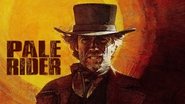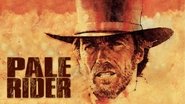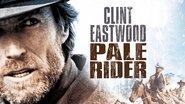jameshally
Directed by and starring Clint Eastwood, pale rider is a must-see for fans of the western genre. Clint Eastwood portrays the enigmatic preacher; a strong/silent type that we've become so accustomed to. Frankly, Eastwood carries this movie as his gunlinging preacher steals every scene. Unfortunately this movie is not without its faults. The movie supporting cast weigh this movie down in a lot of scenes. The characters of mother and daughter, Sarah and Megan were unbearably annoying and made some scenes quite awkward. The villains of lehood and stockburn are quite forgettable but service the plot enough to make it work.
Overall this is a cool western with a great story and a faultless performance from Eastwood.
christopher-underwood
This starts so well and always looks fantastic that it seems churlish to be too critical but it just seems a shame. The views of the mountains, forest and hillside as group on horseback come tumbling through the landscape and the contrast of their menace and determination with the sound of the horses compared with the homely encampment of the prospectors is stunning. Equally as they gradually become aware of the threat of the coming danger is beautifully done. The film continues much in this vein with the added ingredient of the pale rider (actually it is the horse that is pale) and Eastwood always has a marvellous awareness of just how to look and measure his words. Its just I felt that the film dipped a bit in the middle when we are suddenly asked to take the prospectors' private lives seriously and unfortunately the incredibly well set up finale doesn't really live up to the expectations established with the idea of the corrupt Stockburn and his five or was it six similarly dressed deputies.
sharky_55
Eastwood may have been the one to popularise the man with no name, but before he made this gruff remake, and before he shot to fame as the mysterious gunslinger, there was Alan Ladd in the eponymous Shane, who although has his name emblazoned all over, is more or less the same figure. The 1953 western is altogether a dirtier, enclosed affair, despite the state of an ageing, mid 50s Eastwood's beard. When Ladd rides off into the sunset at the close of the tale, his arm hangs limp by his side and the little boy has been shocked that the invincible figure has had his blood spilled. Here is the most noticeable change - Joey Starrett, the puppy dog that dogged Shane's every step and brazenly compared his gunslinging against his own father, replaced by a girl on the verge of womanhood, pretty enough that she thinks she has to fight with her mother for Eastwood. Modelled masculinity is replaced by puppy love then, although the ideal is the same. Eastwood lifts the story from its grimy origins and adds a supernatural flair, serving mostly his own character. He is not just a lonely drifter who wanders into town, but is directly summoned from the heavens by Megan, who prays for a miracle to lift Lahood's reign of terror. The film cites a figure of mythical proportions from the bible itself: "And I saw, and behold, a pale horse, and its rider's name was death, and hell followed him." The archetype lends to this aura; we get no backstory, no name, no explanation, only that he wears the preacher's dress but may not be so godly after all. Hints are scattered: the gunshot scars on his back that no ordinary man could have survived, and the corrupt sheriff's remarks on his now deceased nemesis. The preacher's ability to walk into a cafe and disappear into thin air in the final shootout further lends evidence towards this theory. But in doing so Eastwood gets muddled up in myth and displaces tension. Leone was a master of this, matching movement with music in slow, deliberate strokes. The soundtrack isn't so integral in this instance, and because Eastwood stresses the immaterial, there is nothing thrilling about the actions on screen. One particular sequence, in which a deputy stalks the outhouse, and is rudely interrupted by an errant hand and gun emerging from the trough, elicits silliness and giggles instead. The film seems sandwiched between its origins and the eventuality of the genre. The plot is almost directly copied from Shane, yet Eastwood himself is a weathered old relic of the past, grizzled and scarred and long past his prime, where the clipped dialogue was at optimum coolness. More key signs: the railroad, the most iconic symbol for the impending death of the west, and the machines that Lahood seek to replace hand and tool, great big metal constructs that blast water and dig up the earth to excavate gold. The rest of the residents also seem to be stuck in the wrong timeline. See the friendly giant Club, made ripe from goofy sidekick material, and the ever-hateable Chris Penn as Josh Lahood, with a face built like a high school bully. After Blazing Saddles, could his appearance be anything but ridiculous? Eastwood would have to wait a little bit longer until he fully looked the part, and fashioned Unforgiven, his masterpiece, and fittingly, his last western.
Arne Kristian Lindmo
"Pale Rider" opens up with a beautiful shot of pointy mountains looming behind a lush fir forest which again form the background to dusty plains. Aross this beautiful landscape we see a pack of riders, whipping their horses into a frenzy as they cut through the scenery. Then we cut to an idyllic looking encampment where we see gold prospectors and their families going about their business, a goat here, a dog playfully licking a man's face there... For some time we keep cutting between these two images and we just know that something bad is going to happen. Tension is building slowly until the riders are unleashed upon their victims and make quite the mess. They even shoot a cow and a dog. The dog, we learn, belongs to Megan Wheeler, played by a very young Sydney Penny (Bernadette, 1988) in a wonderful performance. It is her loss and the subsequent burial of the dog which triggers the entrance of the Preacher, through some suggested divine intervention. Clint Eastwood (Heartbreak Ridge, 1986) arrives as an ominous silhouette at first, on the heels of rumbling thunder and shots of rugged mountains, and ending up framed in the doorway of the Wheelers' as Megan finishes her bible reading with the quote: "And I looked, and behold a pale horse. And his name that sat on him was Death." As we learn later, the assault was part of a tactic by the shrewd villain, Coy LaHood, played by Richard Dysart (The Thing, 1982), to drive the prospectors off the land so he can get his hands on the gold which is hidden away in their creek, and Preacher is a man of God coming to lift their spirits and lend a hand. Literary, his introduction to Hull Barret, played by Michael Moriarty (The Stuff, 1985) is in the form of a brawl with LaHood's henchmen where he dispatches divine justice through the conduit of a bat. Eastwood lends heavily on Sergio Leone's archetype: the man with no name, which he himself played to perfection in the 60s, but adds even more mystique to his character through all the religious implications and the semblance of a revenge motif from some mysterious past. Few, if any, can play the tough loner with the icy stare as well as Eastwood, and this character is no exception. Anyone crossing his path with ill intentions are met with silent intimidation of the kind that makes them quickly holster their guns and run away. The movie is not all brawn and myth-making though, the central family trio of prospectors, also including Sarah Wheeler, played by Carrie Snodgress (Murphy's Law, 1986), is the beating heart of the movie. All the performances are top notch. Every word spoken is done so with the utmost conviction and true to character. How Moriarty can churn out such a subtle and dramatically solid performance considering the rest of his 80s catalog (Q, The Stuff, Troll, It's Alive III...) is astonishing. There is some early hints that the young daughter is taking a romantic interest in Preacher, and when words about this is exchanged between the two, it seems certain that few screenplays can match the elegance at which it is handled.For anyone fond of westerns, this is a sure bet for a good time. Some might complain that the overall framework of the plot is formulaic, and if you don't like westerns this will probably not turn you around, but the quality in execution of writing, directing and acting are all top notch. This is a visual movie where the action, the framing of the shots and the gorgeous landscapes dominate the feel and atmosphere of the movie. It is also a movie with excellent use of music and sound, which always help in creating more tension or fleshing out the scenery. The movie is not especially realistic as there are a few logical flaws here and there, but most can be shrugged off as stylistic choices. Sure, it seems strange that one character would reach his destination faster on foot than another character on a horse cart with a head start, or awfully dumb when the main villain stands out in the middle of the street without cover while his men is combing the streets after a hidden and armed Preacher, but his defiance of a sudden death by lead just makes him look even more bad ass, and a worthy opponent for our mythical hero. The 80s were not a happy place for aficionados of the western, but this little gem almost makes up for it.






